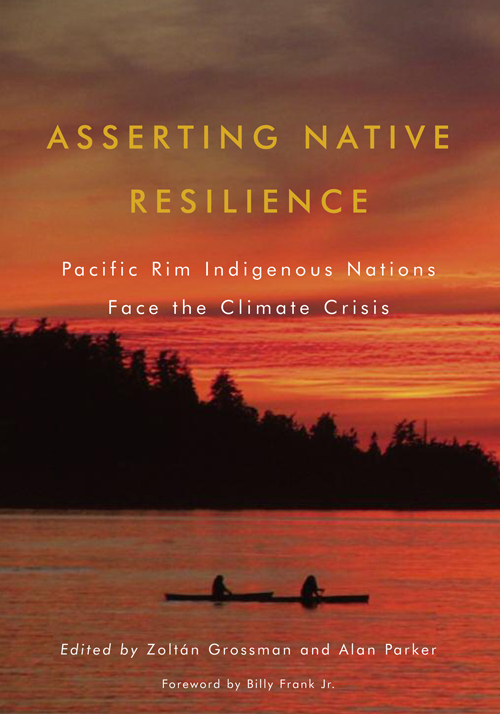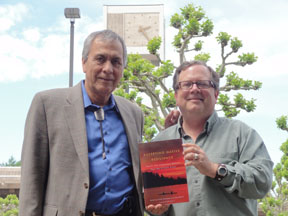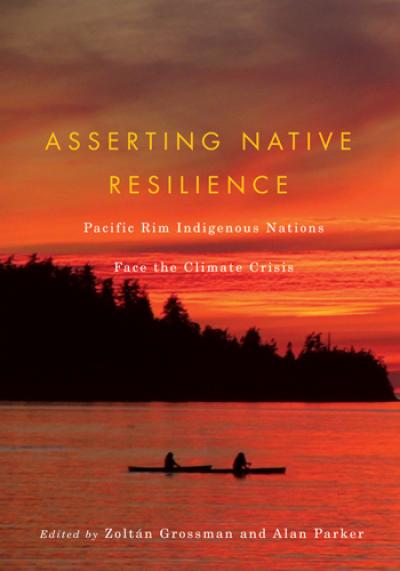Indigenous nations are on the frontline of the current climate crisis. With cultures and economies among the most vulnerable to climate-related catastrophes, Native peoples are developing responses to climate change that serve as a model for Native and non-Native communities alike. The new book Asserting Native Resilience: Pacific Rim Indigenous Nations Face the Climate Crisis presents perspectives on Indigenous responses to the climate crisis, reflecting the voices of more than twenty contributors, including Indigenous leaders and Native and non-Native scientists, scholars, and activists from the Pacific Northwest, British Columbia, Alaska, and Aotearoa/New Zealand. Today, volume editors Zoltán Grossman and Alan Parker talk with us about the inspirations behind this work, the relationship between culture and climate change, and next steps for Native communities and their allies in responding to the climate crisis.
economies among the most vulnerable to climate-related catastrophes, Native peoples are developing responses to climate change that serve as a model for Native and non-Native communities alike. The new book Asserting Native Resilience: Pacific Rim Indigenous Nations Face the Climate Crisis presents perspectives on Indigenous responses to the climate crisis, reflecting the voices of more than twenty contributors, including Indigenous leaders and Native and non-Native scientists, scholars, and activists from the Pacific Northwest, British Columbia, Alaska, and Aotearoa/New Zealand. Today, volume editors Zoltán Grossman and Alan Parker talk with us about the inspirations behind this work, the relationship between culture and climate change, and next steps for Native communities and their allies in responding to the climate crisis.
Why did you put together a volume addressing the climate crisis and Indigenous nations?
Indigenous peoples and their leaders are being systematically left out of the global dialogue around how to respond to climate change, such as the United Nations Framework Convention on Climate Change. We are more likely to hear about an endangered polar bear than we are about the Inuit people living nearby, whose villages are slipping into the sea due to coastal erosion. And the few times we hear in the commercial media about Indigenous peoples and climate change, they are depicted as helpless victims, rather than as sovereign nations with their own innovative ideas and strategies about how to respond to the climate crisis. The Quileute and Hoh in Washington, for example, are moving buildings that house their tribal governments to higher ground and succeeded in having the US Congress authorize them to use part of the Olympic National Park to protect their communities from surging seas. The Nisqually are proactively moving their freshwater source to higher ground, in collaboration with the city of Olympia. Tribal responses such as these are increasingly providing models for their non-Native neighbors.
What inspired this work?
Not that long ago, Indigenous peoples were often described as the “miner’s canary” of climate change, with the premature death of their cultures providing an early warning to the rest of humanity. But because of the important work of Indigenous peoples, they can now be described as a canary that escapes its cage, flaps its wings, and shows the miner the way to escape the toxic gases. In the Pacific Northwest, tribal responses to the destruction of salmon habitat have helped shape how tribes are responding to climate change, in a holistic and collaborative way. The Tulalip Tribes inspired us by being at the forefront of this thinking. The Tulalip are working with dairy farmers to turn cattle waste into renewable biogas energy, keeping it out of salmon streams. They are also exploring ways to store mountain runoff in the flood-prone spring months for release during low-flow summer months, in order to rehydrate the river basins and protect salmon habitat. On the West Coast of the US and in Aotearoa/New Zealand, Indigenous communities are providing emergency shelter in times of disaster to both Native and non-Native neighbors, because they have seen that local and national governments are not as proactive and hospitable.
What do you see as the relationship between culture and climate change?
Native peoples have the traditional ecological knowledge to recognize the changes in the local climate, with many generations of intimate contact with the local landscape and ocean. Indigenous peoples have the sense of community to pull together to face the challenges. Many Native nations possess the political sovereignty (including treaty rights) to be able to implement responses to protect our common natural resources. Native cultures have provided the inspiration and the tools for Indigenous peoples’ resilience in the face of colonization, epidemics, industrialization, and urbanization. Climate change is only one more sickness brought by Western industrialized society. The culture of individualism in Western society has led to shopping malls and mega-food chains making us all increasingly vulnerable to collapse of society in our era of climate change. We now see unprecedented levels of “super-storms,” wildfires, power outages, and water and fuel shortages. In such times of hardship, Native communities can strengthen and draw on traditional food systems, water rights, and kinship networks to hunker down and survive, and engage in planning for a more sustainable future.
What is the Indigenous Nations Treaty and why is it important?
In 2007 in the land of the Lummi Nation, Indigenous representatives from the US, Canada, Australia and Aotearoa/New Zealand gathered together to develop and sign the United League of Indigenous Nations Treaty. The Treaty calls for greater cooperation in the areas of trade, border-crossing rights, cultural resource protection, and response to climate change. Indigenous nations cannot simply rely on the “settler states” to act in their interest, especially when it comes to the tepid responses to climate change acted out today by the US and Canadian governments. The United League of Indigenous Nations Treaty is just one example of how Indigenous peoples and their political leaders are cooperating with each other across imposed colonial boundaries and treaty territories. As fish, animal, and plant species shift outside of their treaty territories due to climate change, Native nations face new challenges to access their traditional resources. One response is cooperation among Native harvesters, such as basket weavers who are starting to trade grasses and reeds with each other to keep access to their shifting supplies.
What is the next step for tribal communities and their allies in responding to climate change?
The first step is to end our country’s addiction to fossil fuels, such as from the Alberta Tar Sands, and to start planning now for a cleaner and sustainable energy future. No matter what else we do, it will be irrelevant if the fossil fuel monster grows in size. But even if we convert to renewable energy tomorrow, we will still face inevitable effects from the greenhouse gases that have already been emitted. Those Native nations that begin to plan for this future now will be better prepared than those who only respond when the disasters arrive. The Swinomish Climate Change Initiative, for example, is building bridges between tribal and local governments in Washington’s Skagit River Delta in its climate change adaptation plans, such as moving roads and other infrastructure out of the way of coastal flooding. The West Coast has become the cutting-edge region for climate change planning and renewable energy, and the tribal communities in the region (such as Swinomish) are on the cutting edge of this work.
 Zoltán Grossman is a professor of geography and Native American and World Indigenous Peoples Studies at The Evergreen State College in Olympia, Washington. Alan Parker is director of the Northwest Indian Applied Research Institute and a professor in the graduate MPA program at The Evergreen State College. Their book, Asserting Native Resilience: Pacific Rim Indigenous Nations Face the Climate Crisis is available for purchase here.
Zoltán Grossman is a professor of geography and Native American and World Indigenous Peoples Studies at The Evergreen State College in Olympia, Washington. Alan Parker is director of the Northwest Indian Applied Research Institute and a professor in the graduate MPA program at The Evergreen State College. Their book, Asserting Native Resilience: Pacific Rim Indigenous Nations Face the Climate Crisis is available for purchase here.
Book editors Alan Parker and Zoltán Grossman.
This interview is crossposted on the First Peoples blog.
Related Titles

Asserting Native Resilience
Indigenous nations are on the frontline of the current climate crisis. With cultures and economies among the most vulnerable to climate-related catastrophes, Native peoples are...
